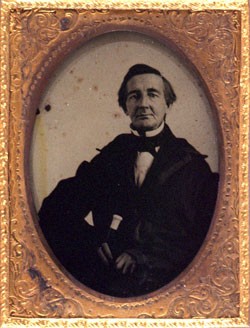
Portrait of an unidentified man with a cane, ca.
1850s. Quarter plate ambrotype. Photographer unknown. |
The Ambrotype
Like a daguerreotype, an ambrotype is a unique positive-negative
image, but the image is a collodion base developed on a glass plate
and appears as a negative until dark lacquer is painted onto the back
of the plate. Ambrotypes have a low-contrast, grey or white appearance
to them, and are easily confused with tintypes. The ambrotype process
was announced in 1851 by the American sculptor Frederick Scott Archer.
As an inexpensive alternative to the daguerreotype, it soon surpassed
the daguerreotype in popularity. It reached its peak circa 1860, but
fell out of favor soon after with the introduction of the carte de
visite albumen photograph.
Despite the popularity of the ambrotype, there are only a few of
these images in the Princeton University Archives. As with daguerreotypes,
ambrotypes were typically housed in miniature cases or protective
frames. The gentleman with the cane pictured here may have been on
the Princeton faculty, or he may have been an alumnus who sent in
his ambrotype portrait to be hung in the college's Portrait Gallery.
continue with conservation
techniques
|